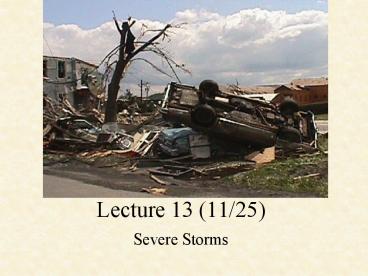Severe Storms - PowerPoint PPT Presentation
Title:
Severe Storms
Description:
... b/c you can usually see the wall cloud and tornado and stay out of it's path ... Tracking Tornadoes. For Next time. Homework is posted. No reading assignment ... – PowerPoint PPT presentation
Number of Views:66
Avg rating:3.0/5.0
Title: Severe Storms
1
Lecture 13 (11/25)
- Severe Storms
2
Severe Storm
- A thunderstorm must have one or more of the
following to be considered a severe storm (NWS
classification) - Winds 58 mph (50 knots) or more
- Hail 3/4 in diameter or larger
- Tornado
3
Supercell Thunderstorms
- A supercell thunderstorm is a t.s. with a deep
rotating updraft (mesocyclone) - Updraft elements usually merge into the main
rotating updraft and then accelerate rapidly - Flanking updrafts "feed" the supercell updraft,
rather than compete with it - Small percentage of all t.s.s are supercells but
they cause the majority of damage
4
Diagram of a Supercell
5
A Look from the SE
6
Types of Supercells
- Low Precipitation - (LP) - high cloud bases,
little precip, large hail and winds more likely
than tornadoes, often form along dryline - High Precipitation - (HP) - occurs in very moist
air, precipitation often wraps around wall cloud
and tornado, hard to see except by Doppler radar,
dangerous to chase (and easy to get dents in car
with)
7
Classic Supercell
- Classic supercell - in between HP and LP
- Most of precip is separated from updraft region
- Good one to chase b/c you can usually see the
wall cloud and tornado and stay out of its path
8
Features of Supercells
- Mesocyclone (p.125) organizes updraft and
downdraft and keeps them separate - Updraft is slanted downwind (aloft) so hail/rain
doesnt fall through it and kill it - Supercell can last for hours and travel a hundred
plus miles - Often moves to the right of the mean flow - has
to do with rotation (vorticity) and propagation - What does propagation mean?
9
How Supercells Move
- Movement Advection Propagation
- This little formula applies to pretty much
everything in weather - advection just the horizontal transport of the
feature (like a supercell) along with the winds - propagation development of the feature (usually
happens towards inflow or flanking line in the
case of a supercell)
10
Overshooting Top
- Overshooting top - characteristic of a strong
updraft - The updraft goes higher than the rest of the
clouds near it (in the anvil) - Overshoots the tropopause or equilibrium level
btwn the troposphere stratosphere - Updraft penetrates stratosphere and then is
forced back down to equilibrium level
11
Overshooting Top
12
Mammatus
- See bottom of p. 167
- Little puffy clouds extending downward from anvil
- Indication of high turbulence and strong
updraft(s) in vicinity - Remember, the harder and more defined cloud
features are stronger than the soft and less
defined features
13
Mammatus pictures
14
Pileus Clouds
- Can form immediately above a growing updraft if
its humid at upper levels - Dont be fooled by the soft appearance of pileus
- they can hide the hard features of the actual
updraft - see p. 176 in text
15
Pileus Picture
16
Anvil
- Strong winds at upper levels usually accompany
supercell thunderstorms (they help the updraft
tilt) - The winds push the anvil along with them at high
speeds (50 mph) - In a strong updraft, a small anvil will blow
upstream too (called backsheared anvil) - Again, the harder the feature, the stronger the
updraft
17
Backsheared Anvil
18
Wall Cloud
- Wall cloud is a region of cloudiness beneath the
rotating updraft region of a thunderstorm - Usually slopes toward the rain and hail shaft
(bottom of wall cloud closer to precip than top) - Must be rotating for it to be classified as a
wall cloud - Often confused with shelf clouds scud
19
Wall Cloud Picture
20
Shelf Cloud
- Usually slopes away from precipitation
- Shelf cloud feature of outflow whereas a wall
cloud feature of inflow
21
Shelf Cloud
22
Beavers Tail
Beavers tail is just a flanking line of inflow
winds
23
Hail
- Hail can be a very destructive force
- Formation
- Starts as frozen raindrop or groupel
- Held aloft by thunderstorms updraft
- Grow from riming or supercooled droplets freezing
to hailstone
24
Hail images
25
More hail
26
Lightning
27
Tornadoes Fujita scale
- F0 Light damage. Wind up to 72 mph.
- F1 Moderate damage. Wind 73 to 112 mph.
- F2 Considerable damage. Wind 113 to 157 mph.
- F3 Severe damage. Wind 158 to 206 mph.
- F4 Devastating damage. Wind 207 to 260 mph.
- F5 Incredible damage. Wind above 261 mph.
28
Tracking Tornadoes
29
For Next time
- Homework is posted
- No reading assignment

